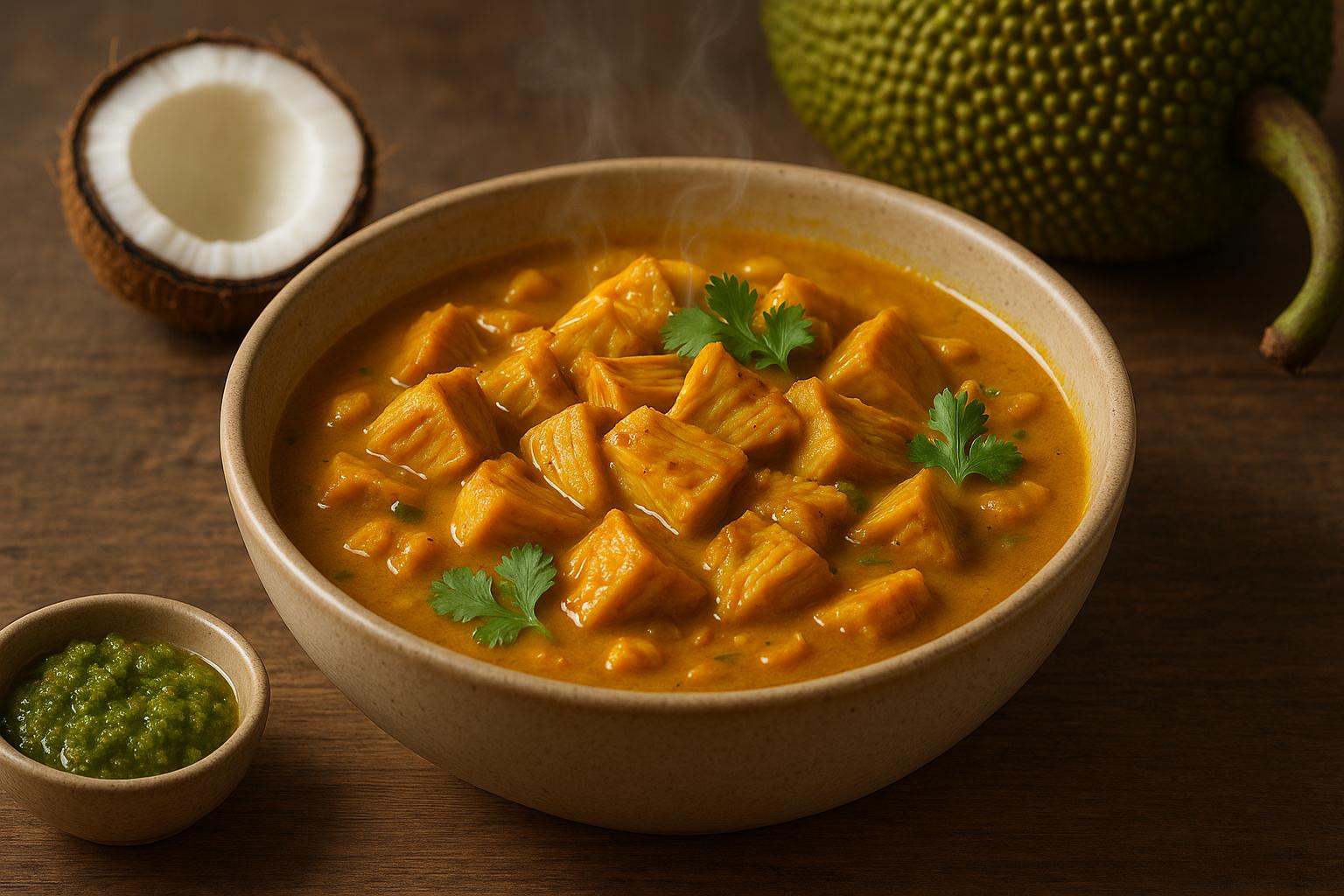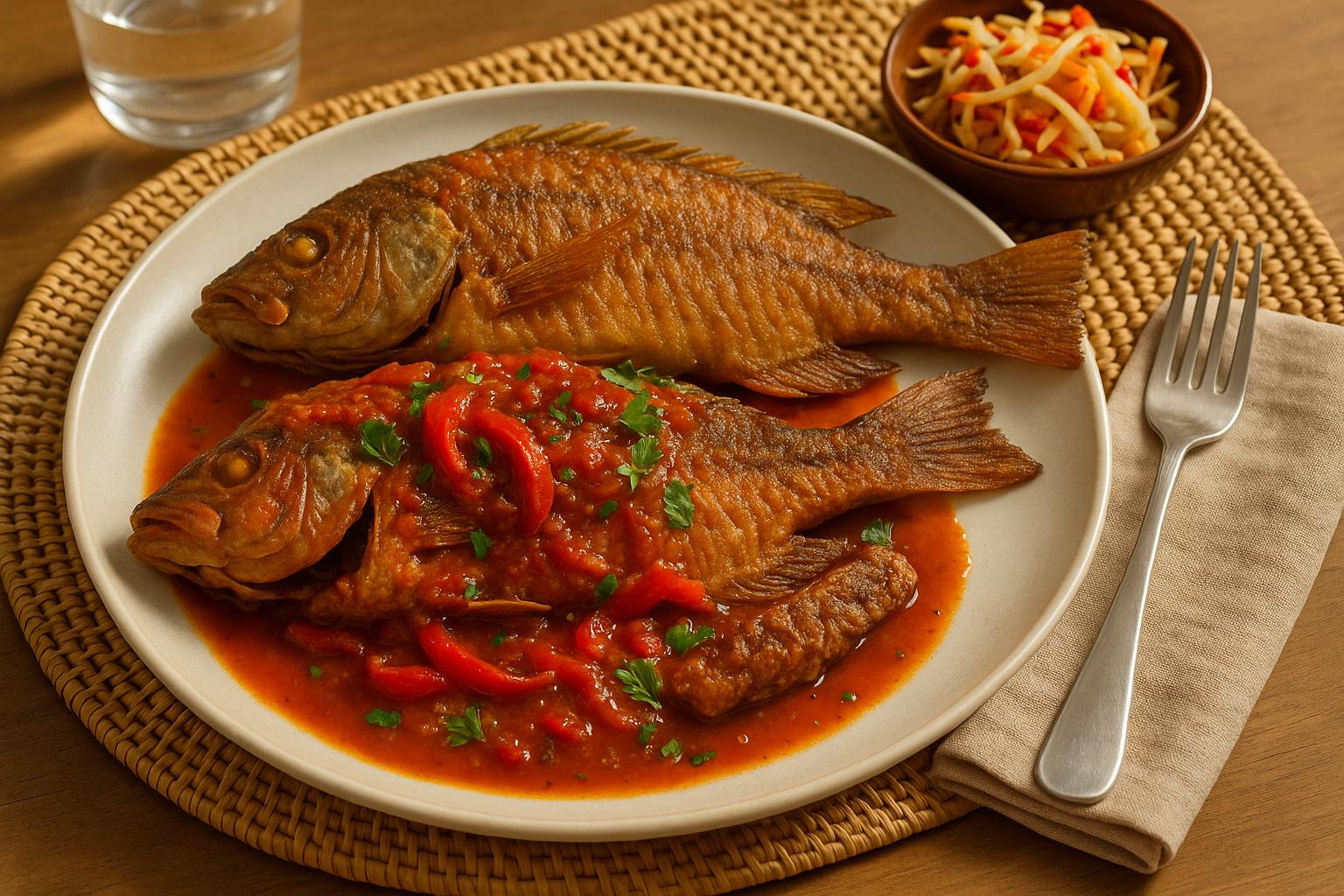Haitian food bursts with bold, layered flavors, thanks to its core components: epis and marinades. Epis, a flavorful green seasoning blend made from garlic, onions, parsley, and peppers, serves as the backbone of Haitian cooking, enhancing everything from meats to stews. Marinades build on this base, infusing proteins with depth using citrus, vinegar, and spices.
- Epis is a paste combining fresh herbs, aromatics, and spices. It’s versatile and used in almost every Haitian dish.
- Marinades, often featuring epis, tenderize and flavor meats, seafood, and vegetables.
- Recipes vary by region and family, with ingredients like scotch bonnet peppers, thyme, and lime juice adding unique twists.
Want to try it? Make epis at home with a blender or mortar and pestle, and store it in the fridge or freezer. Use it to marinate chicken, mix into rice, or even as a spread. Haitian cooking celebrates tradition and flavor, turning simple ingredients into unforgettable dishes.
HAITIAN EPIS 🇭🇹 | EPIS | BASE TO MANY HAITIAN DISHES | HAITIAN GREEN SEASONING || A TASTE OF K
What is Epis: Haitian Seasoning Blend
Epis is a thick, flavorful paste that serves as the cornerstone of Haitian cooking. This green seasoning blend, made from fresh herbs, garlic, onions, and peppers, brings bold, vibrant flavors to a wide range of dishes. Its rich, aromatic profile adds depth to everything it touches, from meats to vegetables, rice, and stews.
Unlike dry spice mixes, epis is a fresh, herbaceous paste. Its thick texture clings beautifully to ingredients, allowing it to deeply infuse meats, penetrate vegetables, and enhance the complexity of stews and rice dishes as they cook.
One of the best things about epis is its versatility and ease of use. You can use it to marinate chicken, stir it into soups, mix it with rice, or as a base for sauces and gravies. Many Haitian households prepare large batches to keep on hand in the fridge or freezer, making it a go-to ingredient for adding authentic Haitian flavor to everyday meals.
Main Ingredients in Epis
The magic of epis lies in its perfectly balanced mix of fresh ingredients, each bringing something special to the table. Fresh parsley and thyme provide the herbal backbone, giving the paste its signature green color and a fresh, earthy flavor.
Garlic and onions add an unmistakable aromatic depth, while a mix of sweet and spicy bell peppers creates layers of flavor ranging from mild sweetness to a subtle kick. Green onions add a sharper, fresher onion flavor that complements the regular onions perfectly.
Other ingredients, like basil and cloves, bring additional complexity, while olive oil binds everything together into a smooth, spreadable paste. Apple cider vinegar is the secret to balancing the rich flavors with a touch of acidity and also helps preserve the blend naturally.
Salt and black pepper round out the seasoning, and cayenne pepper lets you adjust the heat to your liking. Some families also include bouillon paste for an extra layer of flavor, though this is optional and varies by tradition.
| Ingredient | Flavor | Role in Blend |
|---|---|---|
| Fresh Parsley | Herbal freshness, bright color | Primary herb base |
| Garlic | Pungent depth, aromatics | Flavor foundation |
| Bell Peppers | Sweetness and heat balance | Texture and flavor depth |
| Olive Oil | Richness, binding agent | Paste consistency |
| Apple Cider Vinegar | Acidity, preservation | Flavor balance |
How to Make Epis at Home
Making epis at home is simple and rewarding. The traditional method involves using a mortar and pestle, which helps release the essential oils of the herbs for a more authentic flavor. However, a blender or food processor works just as well and is quicker for modern kitchens. Start by blending tougher ingredients like garlic and onions, then gradually add the herbs, oil, and vinegar until you get a chunky, pesto-like paste. Avoid over-blending; epis should have a bit of texture, not be completely smooth.
Proper storage is key to keeping your epis fresh. Store it in an airtight glass jar in the refrigerator for up to 2–3 weeks, always using a clean spoon to avoid contamination. For longer storage, freeze it in ice cube trays - each cube is the perfect portion for a single meal.
Different Types of Epis Recipes
Epis recipes vary widely across Haiti, reflecting regional influences and family traditions. Some versions lean into the heat by adding more scotch bonnet peppers, while others emphasize herbal notes with extra basil or culantro, a Caribbean herb similar to cilantro.
In northern Haiti, cooks may include more cloves and allspice for a warm, spiced flavor. Coastal areas often swap apple cider vinegar for lime juice, giving the blend a brighter, tropical acidity.
For those cooking outside of Haiti, ingredient substitutions make epis accessible. If scotch bonnet peppers are hard to find, jalapeños or serranos can deliver a similar heat. Culantro can be replaced with cilantro, though the flavor will differ slightly. Apple cider vinegar can be swapped for white wine vinegar, and a touch of honey can help balance spicier versions.
The beauty of epis lies in its flexibility. You can tweak the heat, herbs, and acidity to suit your taste or the ingredients you have on hand. Start with a basic recipe and adjust it over time, creating your own version of this Haitian staple. This adaptability captures the heart of Haitian cooking - where tradition and creativity come together seamlessly.
How Marinades Work in Haitian Cooking
In Haitian cuisine, marinades play a crucial role in elevating dishes with layers of flavor. Building on the aromatic foundation of epis, marinades work their magic by infusing meats, poultry, and seafood with depth and complexity. The secret lies in their key components: acids, oils, and aromatics. Acids like citrus juice and vinegar not only add a tangy brightness but also help break down proteins, making the food more tender. Oils, on the other hand, act as carriers for fat-soluble flavors, ensuring that every bite is rich and satisfying. Aromatic ingredients - often led by epis - bring in the signature blend of herbs and spices that define Haitian cooking.
What makes Haitian marinades stand out is their adaptability. They’re used across a variety of proteins, creating dishes that are flavorful and uniquely layered.
What Goes into Haitian Marinades
At the heart of a Haitian marinade is epis, which serves as a flavorful base. Citrus juices, particularly lime, are essential for their bright acidity and tenderizing properties, while vinegar adds an extra tang and helps preserve the marinade. For heat, scotch bonnet peppers are a favorite, offering not just spice but also a fruity undertone that complements the other ingredients.
Some modern takes on Haitian marinades include soy sauce, which brings a savory depth and saltiness. For instance, in November 2023, Lemon8 user cliffordsertyl1 described Marinad Haitiano (Haitian fried chicken) as featuring "a marinade that combines soy sauce, vinegar, and spices, including scotch bonnet pepper" [4]. Additional components like thyme and a touch of oil help to round out and harmonize the flavors.
Marinating Methods for Common Dishes
Once the marinade is prepared, the method of marination can vary depending on the protein. For Haitian fried chicken, the meat is typically marinated for several hours before being fried to a crispy, golden perfection [4]. Tougher cuts of beef or pork benefit from longer marination times, allowing the acids to tenderize the meat fully. On the other hand, fish and seafood require only a short marination period to avoid over-tenderizing or breaking down the delicate texture.
To ensure the best results, always marinate in the refrigerator and use non-reactive containers, such as glass or plastic. This not only ensures even flavor distribution but also maintains food safety throughout the process.
sbb-itb-80c33ff
Using Haitian Seasonings in Your Kitchen
Incorporating Haitian flavors into your cooking doesn’t require a complete kitchen makeover. With their bold and concentrated taste, these seasonings can effortlessly enhance your everyday meals. Let’s dive into how you can bring the magic of epis into your dishes.
Adding Epis to Regular Meals
Epis is a powerhouse seasoning that works as a base for countless dishes. Its flexibility makes it a go-to ingredient for various cooking styles, reflecting the rich culinary traditions of Haiti.
Want to start small? Add a teaspoon of epis to scrambled eggs for a flavorful twist. Blend it with mayonnaise for a zesty spread on toast, or use it as a marinade for meats before grilling. As The Generalissimo puts it:
"Stir epis into scrambled eggs, mix it with mayo, use it as a marinade or just eat it straight – no matter what you do, epis is a most flavorful condiment that BELONGS in your repertoire, Citizens!" [6]
Rice and grain dishes also benefit from the addition of epis. Stir in a tablespoon or two during cooking to instantly elevate their flavor. Simply Recipes, in July 2024, highlighted its versatility, suggesting it can even be used "like a pesto with pasta and protein" [5].
Soups and stews gain depth when you add epis early in the cooking process. Start with a tablespoon and adjust to your taste - it can turn a basic soup into something extraordinary. Roasted vegetables also get a flavor boost when tossed with epis before roasting, creating caramelized edges with a complex, savory kick.
Tips for American Home Cooks
To make the most of epis, proper storage and marination techniques are key. Store homemade epis in a glass jar with a tight lid in the refrigerator, where it will stay fresh for up to a month. For longer storage, freeze it in portions for easy use later [7][1].
When marinating proteins, timing matters. For tender cuts, 30 minutes is enough to infuse flavor, while tougher cuts benefit from marinating for up to 12 hours to allow the seasoning to penetrate deeply [8]. In November 2024, an Allrecipes user shared how they successfully swapped lemon juice for lime or apple cider vinegar when preparing Haitian-inspired dishes, showcasing the adaptability of epis [8].
Why Epis and Marinades Matter in Haitian Culture
Haitian cuisine is more than just food - it's a reflection of identity, history, and community. At the heart of this culinary tradition are epis and marinades, which serve as flavorful bridges connecting generations. These seasonings tell the story of a resilient nation, blending influences from African, French, Spanish, and indigenous Taíno cultures. As food writer Sam Oriach puts it:
"Haitian food is more than just a meal. It's a living history. Drawing from African, French, Spanish, and indigenous Taíno influences, Haitian cuisine has evolved into one of the Caribbean's most vibrant and distinctive food traditions." [9]
Epis, a fragrant blend of herbs, spices, and aromatics, embodies centuries of culinary evolution. Each spoonful carries the essence of Haiti's rich history, transforming dishes into something uniquely Haitian. Beyond flavor, this seasoning fosters a sense of community, especially during celebrations where food becomes a centerpiece of togetherness.
Part of Haitian Celebrations
The cultural significance of epis and marinades shines during Haiti's most cherished celebrations. These ingredients elevate everyday meals and turn festive gatherings into unforgettable experiences. For example, griyo, a beloved dish of pork marinated in sour orange juice and epis, then simmered and fried, often takes center stage at family parties and special occasions [9].
One of Haiti's most meaningful culinary traditions unfolds on January 1, Haitian Independence Day, with Soup Joumou. This iconic pumpkin soup, seasoned with epis and a medley of traditional spices, symbolizes freedom and independence. Families across Haiti and the diaspora prepare this dish using recipes passed down through generations, honoring their ancestors and commemorating Haiti's hard-won liberty [9].
Other festive occasions, like weddings and holidays, feature dishes richly seasoned with epis. These meals are often paired with cremas, Haiti's signature creamy drink, adding another layer of warmth and celebration to the table [9].
What Makes Haitian Food Special
The magic of Haitian cuisine lies in how epis and marinades preserve the nation's cultural identity in every bite. This signature blend combines fresh herbs like parsley, cilantro, and thyme with aromatics such as garlic, onions, and bell peppers. The fiery kick of Scotch bonnet peppers rounds out the flavor, creating a profile that instantly identifies a dish as Haitian [9].
Chef Vanesa Cantave's Haitian Cashew Chicken is a perfect example of this culinary artistry. Her recipe features lime-washed chicken thighs simmered in epis alongside onions, tomatoes, and Scotch bonnet peppers, offering a delicious glimpse into the flavors of Northern Haiti [9].
Chef Nadege Fleurimond beautifully sums up the deeper meaning of Haitian cuisine:
"Haitian food culture is an expression of identity, resilience, and community. It is the way we honor our history, celebrate life, and connect with each other. It's about storytelling, pride, and a legacy of blended cultural influences." [10]
Getting Started with Haitian Seasonings
Now that we've explored the cultural significance of epis and marinades, it's time to bring these bold Haitian flavors into your own kitchen. The good news? It's simpler than you might expect, and the results can transform your cooking. Here's a quick guide to help you dive right in.
Gather Your Ingredients
To make authentic epis, you'll need a handful of fresh ingredients. As Manie Chery describes it, epis is "a marinade of blended herbs, veggies, and spices" that "gives Haitian food its delicious unique taste!" [2]. The essentials include:
- Fresh parsley
- Cilantro
- Thyme
- Garlic
- Onions
- Bell peppers
- Scotch bonnet peppers (for heat)
One of the best things about epis is its adaptability - feel free to tweak the ingredients to match your preferences or what you have on hand.
Tools and Preparation
Using a blender or food processor will make the process much easier and faster. To prepare, chop all the ingredients into even pieces. Skip adding water; the natural moisture from the vegetables will do the job [3].
Once blended, store your epis in an airtight container. It keeps well in the refrigerator for up to three months, or you can freeze smaller portions to use later [5].
How to Use Epis
The versatility of epis is what makes it such a staple in Haitian cooking. Use it to marinate meats, enhance soups and stews, or even mix a spoonful into everyday dishes for an extra flavor boost. If you prefer less heat, you can tone it down by reducing or replacing the Scotch bonnet peppers [5].
With your homemade epis ready to go, you're set to explore the vibrant, layered flavors that define Haitian cuisine.
FAQs
What can I use to adjust the heat in epis if I don’t have scotch bonnet peppers?
If you can't find scotch bonnet peppers, habanero peppers are a great alternative with a comparable heat and flavor profile. Looking for something milder? Swap them out for bird’s eye chilies or sprinkle in a bit of cayenne pepper to dial in the spice to your liking. Adjust the amount based on your personal heat preference!
What can I use as substitutes for ingredients in Haitian epis if I can’t find certain herbs or spices?
If you're having trouble sourcing specific ingredients for Haitian epis, don't worry - you can still capture its bold flavors with a few simple substitutions. For Scotch bonnet peppers, you can use habanero peppers, bird's eye chilies, or even a pinch of cayenne pepper as an alternative. Missing fresh herbs like thyme or parsley? Dried versions are a great stand-in - just remember to use about one-third of the fresh amount since dried herbs are more potent. These easy swaps will help you keep the vibrant essence of epis, even if you're working with a limited pantry.
What makes Haitian marinades unique, and how do they enhance the flavor of dishes?
Haitian marinades are known for their bold and lively flavors, thanks to a traditional seasoning mix called epis. This flavorful blend typically combines fresh ingredients like garlic, onions, parsley, thyme, and scotch bonnet peppers. A splash of vinegar or citrus juice adds a tangy brightness that ties everything together.
What makes these marinades stand out is the scotch bonnet peppers. They don’t just bring heat - they add a fruity, aromatic quality that’s hard to replicate. Paired with fresh herbs, they create a deeply layered base that enhances the flavor of meats, seafood, and even vegetables. The result? Haitian dishes that are bursting with complexity and impossible to forget.


